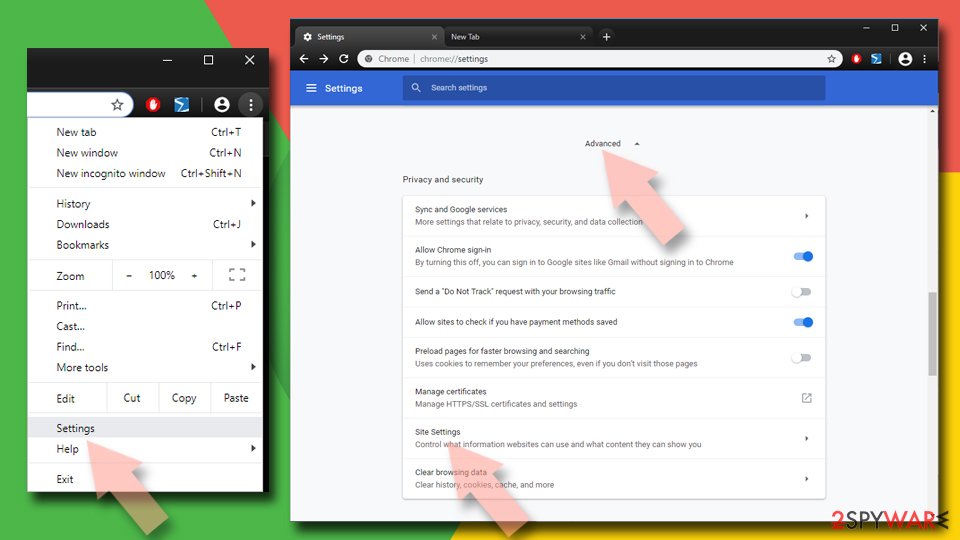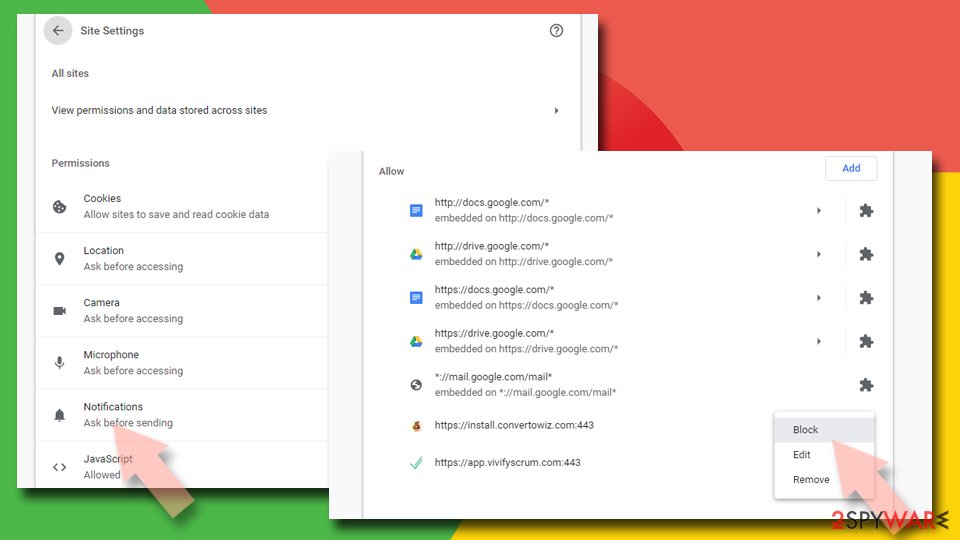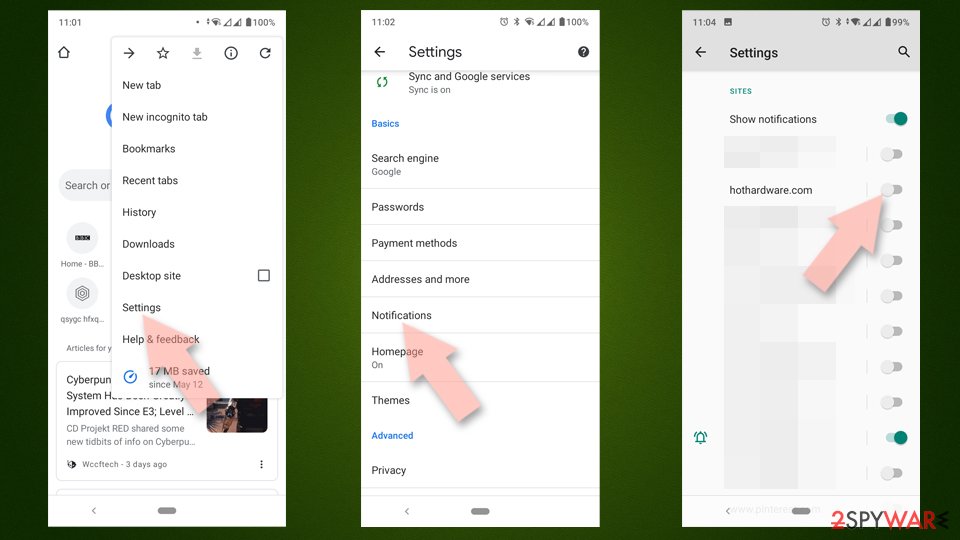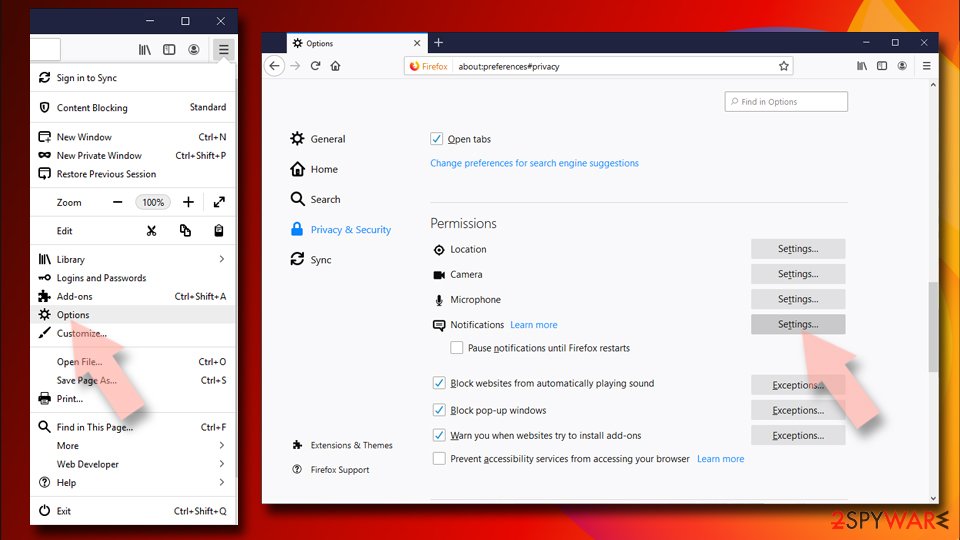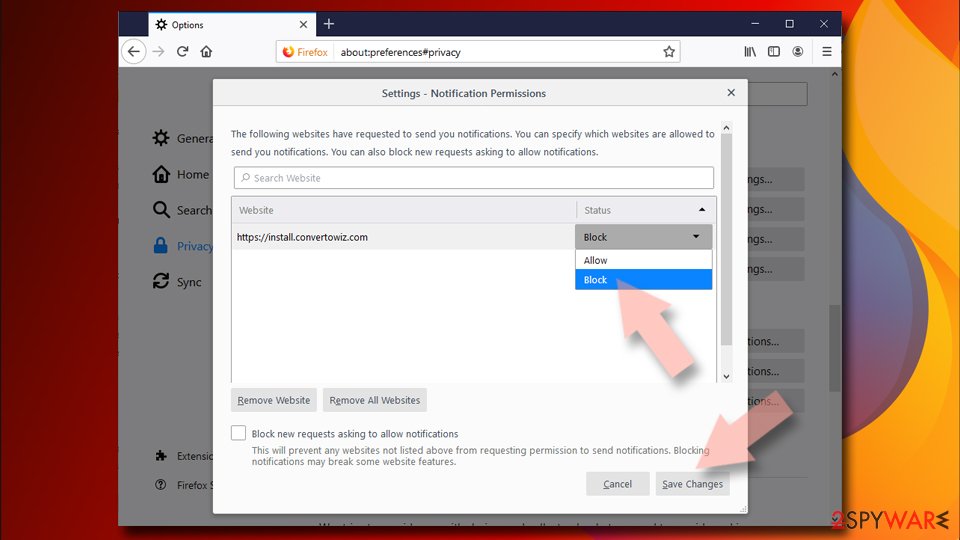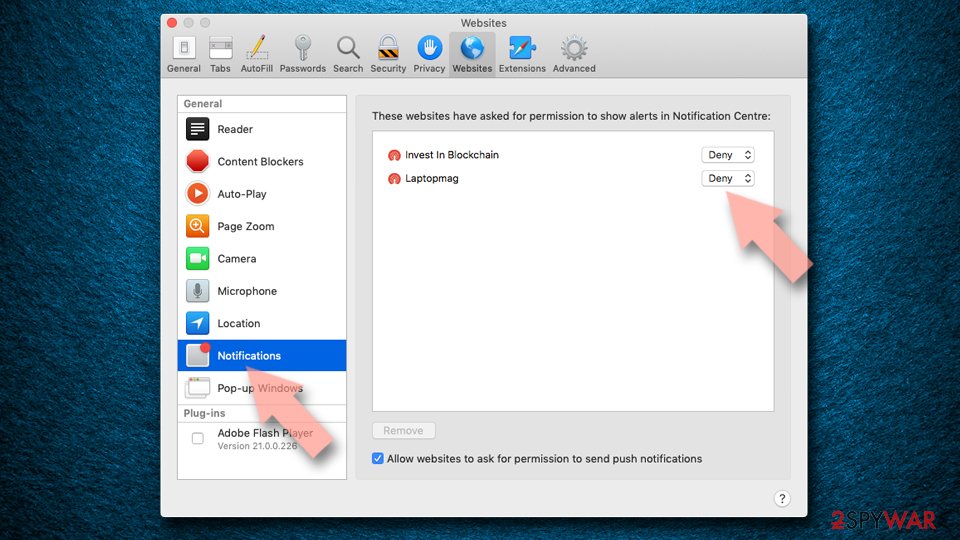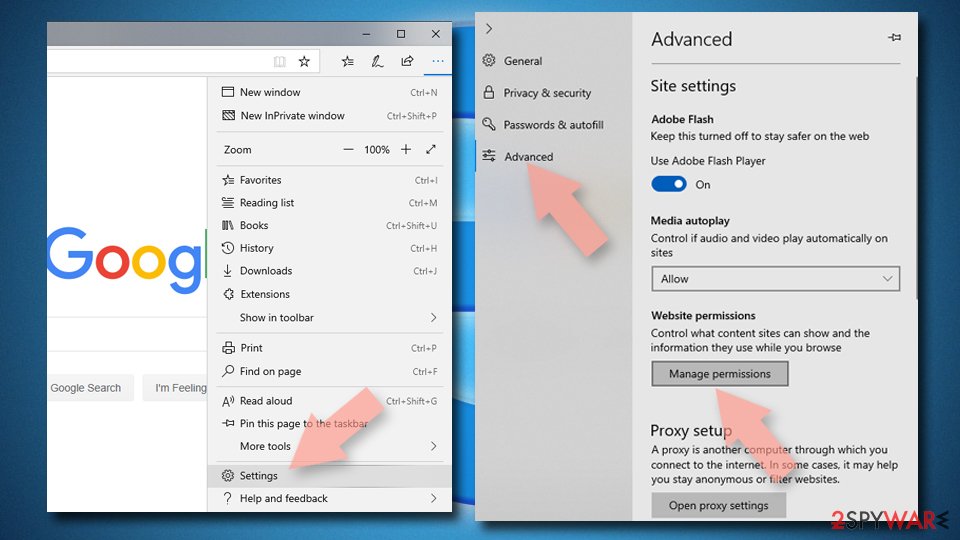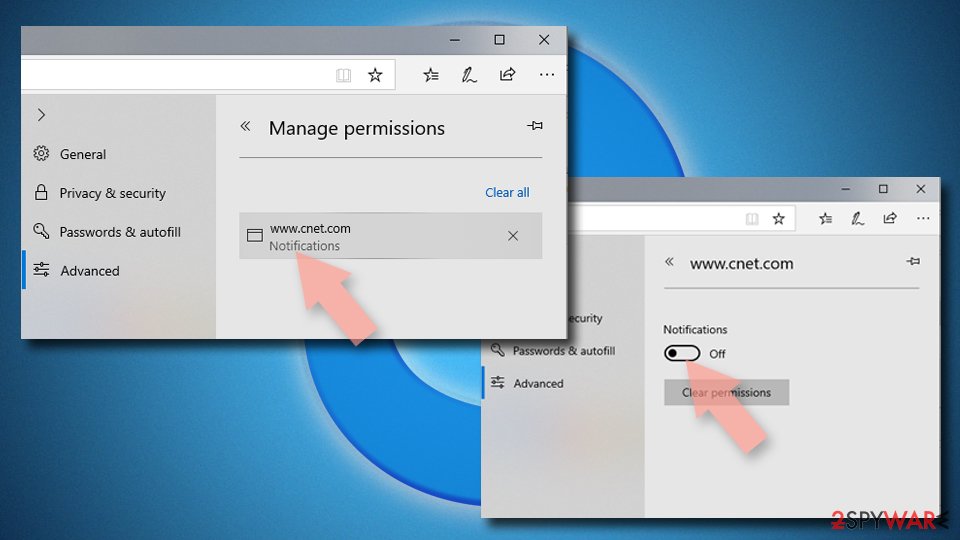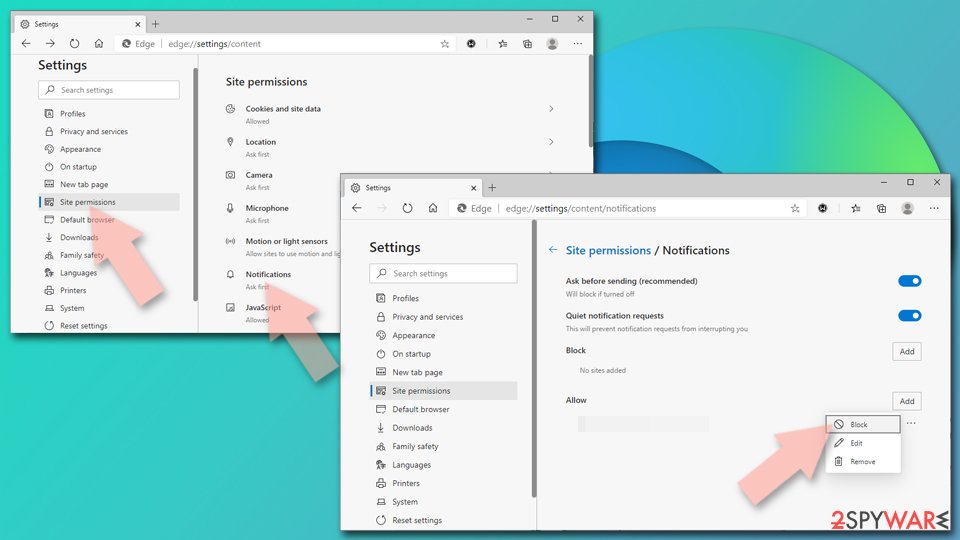Myhypeposts.com ads (spam) - Free Guide
Myhypeposts.com ads Removal Guide
What is Myhypeposts.com ads?
Myhypeposts.com tries to fool users into getting spammed with annoying pop-up ads

Myhypeposts.com is a dubious website that pretends it has a video to watch. It asks users to click the “Allow” button so they could be able to “continue watching.” In reality, this page does not have any content to explore, and the button grants permission for the page to send push notifications.
People start getting spammed with annoying pop-up ads that can lead to dangerous pages. Users may end up on scam sites that can trick them into providing personal information or downloading PUPs (potentially unwanted programs),[1] and malware. The reason behind this is that the creators of the site do not care about user privacy or security.
Fraudsters sometimes even use unsafe advertising networks and do not filter which ads can show up on people's screens. In some cases, ads pop up promoting adult, and gambling sites. If there are other members in the family using the affected machine, especially younger ones, it is important to get rid of push notification spam as soon as possible before it leads to more serious problems.
| NAME | Myhypeposts.com |
| TYPE | Push notification spam; adware |
| SYMPTOMS | Intrusive pop-up ads start appearing in the corner of the screen |
| DISTRIBUTION | Shady websites, misleading advertisements, bundled software |
| DANGERS | The website could be using unsafe advertising networks that place ads leading to dangerous websites where people can get tricked into providing their personal information or installing PUPs and malware |
| ELIMINATION | Go to your browser settings and disable push notifications |
| FURTHER STEPS | Use a repair tool FortectIntego to fix any remaining damage and clear your browsers |
The removal process
1. Disable push notifications
If you have had enough of annoying pop-ups and do not want to see scammy ads on your screen, you can remove Myhypeposts.com permissions manually by going to your browser settings. Keep in mind that this might not work if you have an adware[2] infection. If removal from the browser will not work, you will have to access your programs section in the device and find it manually or scan your machine with professional security tools.
Google Chrome (desktop):
- Open Google Chrome browser and go to Menu > Settings.
- Scroll down and click on Advanced.
- Locate the Privacy and security section and pick Site Settings > Notifications.
![Stop notifications on Chrome PC 1 Stop notifications on Chrome PC 1]()
- Look at the Allow section and look for a suspicious URL.
- Click the three vertical dots next to it and pick Block. This should remove unwanted notifications from Google Chrome.
![Stop notifications on Chrome PC 2 Stop notifications on Chrome PC 2]()
Google Chrome (Android):
- Open Google Chrome and tap on Settings (three vertical dots).
- Select Notifications.
- Scroll down to Sites section.
- Locate the unwanted URL and toggle the button to the left (Off setting).
![Stop notifications on Chrome Android Stop notifications on Chrome Android]()
Mozilla Firefox:
- Open Mozilla Firefox and go to Menu > Options.
- Click on Privacy & Security section.
- Under Permissions, you should be able to see Notifications. Click Settings button next to it.
![Stop notifications on Mozilla Firefox 1 Stop notifications on Mozilla Firefox 1]()
- In the Settings – Notification Permissions window, click on the drop-down menu by the URL in question.
- Select Block and then click on Save Changes. This should remove unwanted notifications from Mozilla Firefox.
![Stop notifications on Mozilla Firefox 2 Stop notifications on Mozilla Firefox 2]()
Safari:
- Click on Safari > Preferences…
- Go to Websites tab and, under General, select Notifications.
- Select the web address in question, click the drop-down menu and select Deny.
![Stop notifications on Safari Stop notifications on Safari]()
MS Edge:
- Open Microsoft Edge, and click the Settings and more button (three horizontal dots) at the top-right of the window.
- Select Settings and then go to Advanced.
- Under Website permissions, pick Manage permissions and select the URL in question.
![Stop notifications on Edge 1 Stop notifications on Edge 1]()
- Toggle the switch to the left to turn notifications off on Microsoft Edge.
![Stop notifications on Edge 2 Stop notifications on Edge 2]()
MS Edge (Chromium):
- Open Microsoft Edge, and go to Settings.
- Select Site permissions.
- Go to Notifications on the right.
- Under Allow, you will find the unwanted entry.
- Click on More actions and select Block.
![Stop notifications on Edge Chromium Stop notifications on Edge Chromium]()
2. Delete cookies and cache
After successful removal, you need to take care of your browsers separately. With the help of cookies,[3] shady websites you visit can collect data about your browsing activities. That includes your IP address, websites you visit, links you click on, and purchases you make online.
Generally, cookies are not bad. Websites and web-based apps can use them to personalize the user experience – show relevant results, and suggestions. However, if they ended up in the wrong hands, they can be sold to advertising networks or other third parties and used to target you with ads even more.
The easiest way to get rid of cookies and cache is by using a maintenance tool like FortectIntego. It can do everything with a click of a button automatically so you do not have to worry about it. Besides, this powerful software can fix various system errors, corrupted files, and registry issues which is especially helpful after a virus infection.

3. Remove suspicious applications from your machine
If none of the above methods worked and you still experience symptoms like an increased amount of commercial content, banners, surveys, redirects you might have adware hiding in your system. These programs often infiltrate the systems as bundled software from freeware[4] distribution sites.
Adware can act in the background of your machine – generate ads and collect revenue for it. Freeware distribution sites include them in the installers so their activity is profitable. They can generate revenue from PPC, PPV, and other advertising methods available online.
If you want to avoid such intruders in the future, you should always choose the “Custom” or “Advanced” installation method, read the Privacy Policy and Terms of Use. The most important step is to look at the file list and untick the boxes next to any additional programs that you do not need.
Manual removal of PUAs can get tricky if you do not have experience. Developers often disguise PUAs as handy tools, like antivirus software, system optimizers, or media players. You might not even suspect the program that is at fault for unwanted behavior.
If you have no idea which app is responsible for such activities, you should deploy SpyHunter 5Combo Cleaner or Malwarebytes professional security software that will perform a full system scan and eliminate it automatically. They can also prevent such infections in the future by warning you. If you still prefer doing it yourself, here are step-by-step instructions for Windows and macOS:
Instructions for Windows 10/8 machines:
- Enter Control Panel into Windows search box and hit Enter or click on the search result.
- Under Programs, select Uninstall a program.
![Uninstall from Windows 1 Uninstall from Windows 1]()
- From the list, find the entry of the suspicious program.
- Right-click on the application and select Uninstall.
- If User Account Control shows up, click Yes.
- Wait till uninstallation process is complete and click OK.
![Uninstall from Windows 2 Uninstall from Windows 2]()
If you are Windows 7/XP user, proceed with the following instructions:
- Click on Windows Start > Control Panel located on the right pane (if you are Windows XP user, click on Add/Remove Programs).
- In Control Panel, select Programs > Uninstall a program.
![Uninstall from Windows 7/XP Uninstall from Windows 7/XP]()
- Pick the unwanted application by clicking on it once.
- At the top, click Uninstall/Change.
- In the confirmation prompt, pick Yes.
- Click OK once the removal process is finished.
For macOS users:
- From the menu bar, select Go > Applications.
- In the Applications folder, look for all related entries.
- Click on the app and drag it to Trash (or right-click and pick Move to Trash)
![Uninstall from Mac 1 Uninstall from Mac 1]()
To fully remove an unwanted app, you need to access Application Support, LaunchAgents, and LaunchDaemons folders and delete relevant files:
- Select Go > Go to Folder.
- Enter /Library/Application Support and click Go or press Enter.
- In the Application Support folder, look for any dubious entries and then delete them.
- Now enter /Library/LaunchAgents and /Library/LaunchDaemons folders the same way and terminate all the related .plist files.
![Uninstall from Mac 2 Uninstall from Mac 2]()
Distribution methods
For users to avoid such issues in the future, it is important to know where they can find them. Probably unsurprisingly, pages like Myhypeposts.com can rarely be found in the search results. Most of the time users get redirected from other already shady websites. These could be, for example, illegal streaming platforms.
Even though Google said it would get rid of fake “Download” and “Play” buttons, they still exist. They open new tabs and take users to random websites that are promoted by a particular advertising network used by the website. By chance, a page like this one can appear.
Many users think that it is the same website and they do anything to watch the TV show or movie they want. Users rush and do not read the prompts that they click on fully. Nowadays, there are plenty of streaming services where people only have to pay a small monthly subscription fee to watch as much content as they want. It is not worth surfing through questionable websites on the Internet, especially if you are not aware of various social engineering tactics used by crooks.
How to prevent from getting adware
Choose a proper web browser and improve your safety with a VPN tool
Online spying has got momentum in recent years and people are getting more and more interested in how to protect their privacy online. One of the basic means to add a layer of security – choose the most private and secure web browser. Although web browsers can't grant full privacy protection and security, some of them are much better at sandboxing, HTTPS upgrading, active content blocking, tracking blocking, phishing protection, and similar privacy-oriented features. However, if you want true anonymity, we suggest you employ a powerful Private Internet Access VPN – it can encrypt all the traffic that comes and goes out of your computer, preventing tracking completely.
Lost your files? Use data recovery software
While some files located on any computer are replaceable or useless, others can be extremely valuable. Family photos, work documents, school projects – these are types of files that we don't want to lose. Unfortunately, there are many ways how unexpected data loss can occur: power cuts, Blue Screen of Death errors, hardware failures, crypto-malware attack, or even accidental deletion.
To ensure that all the files remain intact, you should prepare regular data backups. You can choose cloud-based or physical copies you could restore from later in case of a disaster. If your backups were lost as well or you never bothered to prepare any, Data Recovery Pro can be your only hope to retrieve your invaluable files.
- ^ Chris Hoffman. PUPs Explained: What is a “Potentially Unwanted Program”?. Howtogeek. Technology Magazine.
- ^ Adware. Malwarebytes. Cybersecurity Basics.
- ^ What are Cookies?. Kaspersky. Home Security.
- ^ Tim Fisher. What Is Freeware?. Lifewire. Internet, Networking and Security Blog.
